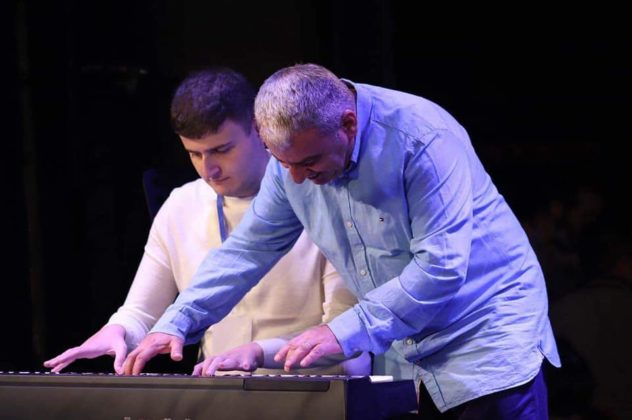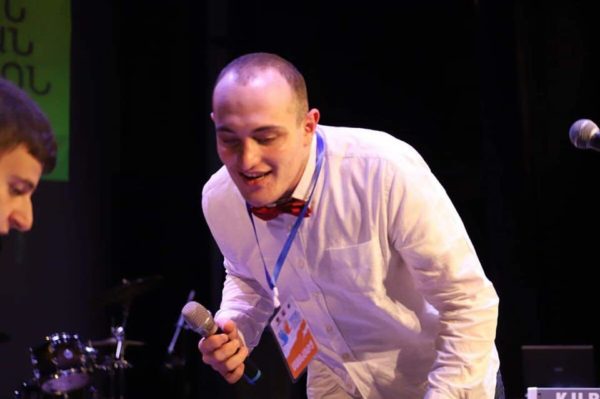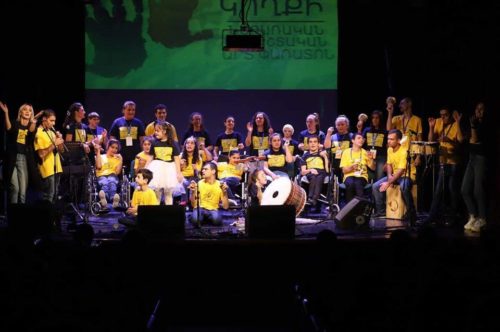
Vardan and Vahagn Hayrapetyan
Celebrating Inclusiveness through Art
by Muriel Mirak-Weissbach
YEREVAN, OCTOBER 28, 2021 — Art is inclusive. Creativity, that uniquely human characteristic, is by definition universal. No matter what age or sex, from what culture or geographical region, every human being is endowed with the ability to create, and art is the way we celebrate that capacity.
Nowhere is this more evident than in cultural events featuring youngsters with disabilities. In Yerevan earlier this month, the «ԿՈՂՔ ԿՈՂՔԻ» “Side by Side” State Musical Inclusive Art Festival took place, presenting both the visual and performing arts. Financed by a grant provided by the Ministry of Education, Science, Culture and Sports of the Republic of Armenia in August, the project goes under the name of Inclusive Programs and Projects in the Sphere of Contemporary Art. The applicant is the Autism National Foundation, and the founder and director of the festival itself is Naira Sargsyan, who is the Music Therapist at the Foundation’s MY WAY Educational, Rehabilitation and Vocational Training Center for people with autism.
The festival took place on October 1 and 4, at the Hovhannes Tumanyan State Puppet Theatre, small and large concert halls respectively. The foyer of the theater hosted an exhibition of art works, handmade souvenirs and crafts, which students from all the participant specialized centers had created. And in the halls, the musical programs were performed, by students of all ages.

Raphael
Nationwide Participants, Unified Concept
Preparations for the festival were extensive and intensive. Eleven specialized centers from all over Armenia came on board, and communicated both online and in person. They united around one idea: to create the means for the children and youngsters to be able to demonstrate their talents to society, in the name of development and inclusion in the field of arts. The centers included MY WAY Educational, Rehabilitation and Vocational Training Day Care Center, Source House Development Center, LUSE Social-Rehabilitation Center, Arev-Erekhaner Children with Down Syndrome Health and Development Center, Emili Aregak Rehabilitation Center of Gyumri, Regional Pedagogical-Psychological Support Center of Spitak, Mayri Center of Curative Pedagogy and Social Therapy, Kharbert Specialized Children’s Home, Zatik Child Assistance Center, Yerevan MANKAN TUN Orphanage and Sevan Children Rehabilitation Center. Students from the Aregnazan School, which is not a specialized school but inclusive, and the Sevan-based Music School named after Valery Sargsyan, also took part in the event.
Once a program had been developed, each musical number had to be learned and rehearsed. Fourteen professional musicians and musical collectives were engaged in joint numbers with the students with special needs, and conducted more than 30 rehearsals in specialized premises. In addition to the 10 people directly engaged in project execution, 40 volunteers and 40 specialists aided in the festival preparations and implementation.Well in advance of the opening event, the public learned of the festival through widespread coverage on the internet. Naira Sargsyan gave interviews, both in the framework of TV programs and at the My Way Center in Yerevan, explaining the concept of the festival, and the importance and success of inclusion. The invitation to attend was open and attendance was high. On the first day, designed more for younger performers, there were 30 participants on stage and 100 spectators. The program included a shadow play, students from the LUSE and Zatik Centers performing Nouneh Sargsyan’s fairytale, “The Bald Hedgehog.” On October 4, the festival concluded with a gala concert, featuring 60 participants and 300 spectators, including many prominent public figures.
On the Scene
No second-hand description can replace an eye-witness report. Sona Petrosyan, the My Way co-founder and board member, who is the source of this article, shared her enthusiastic account of the process, from preparations to performances. “The atmosphere at the rehearsals I attended was so warm, and the musicians were very patient and flexible, always ready to help, devoted and enthusiastic. Good for them!” she said. “Overall, it was really a tremendous job,” she continued, “labor-intensive, emotional and overwhelming (in a good way). The idea of uniting so many different centers itself was challenging and the importance of these events cannot be overestimated. Everything that happened on stage was unique, touching, with unprecedented vibe. The mood and spirit of every performance was so intense and contagious, that the whole space, the auditorium and the stage, the performers and the spectators, became onе. There was not a single bitter emotion or feeling of sadness or pity — we all felt only joy, amazement, pride and affection, and gratefulness to all those who took part, joining our special children and youngsters on stage, with such grace, kindness, an open mind and empathy. The sense of gratitude was deep and widespread, for individuals who were working with special people, directly or indirectly, supporting them, advocating their rights and making their lives better. And all our students were happy, performing and being engaged, being accepted and enthusiastically greeted, encouraged and sincerely valued.”
Petrosyan was especially moved by the musical performances, “always full of surprises; every number is a ‘living organism,’ and this spontaneity and authenticity of our students always makes you smile.”
She cited the example of Vardan, a student both at My Way and the State Music College, in “an outstanding ragtime number with famous jazzman Vahagn Hayrapetyan. It was the last number of the concert. Up to that moment, they had used only one keyboard on stage, and Vardan was sitting and waiting for the second one to be brought in for the jazzman. This took some time, so Vardan decided not to wait and started his ragtime. The musician immediately joined him and was improvising standing next to him, playing from the right side, then from the left, it was awesome! The second keyboard was never used! And it came out even better!”

My Way inclusive music festival
In addition to Vahagn Hayrapetyan, there were a number of top musicians joining the youngsters on stage: Ruben Hakhverdyan, Miqayel Voskanyan and MVF band, Konstantin Abgaryants, Lav Eli rock band, Nemra, Hope For Coffee band, Lidushik, Colors of Music band, Anna Mkhitaryan and Anahit Mkhitaryan, Hayk Petrosyan and David Ghazaryan.
Sona Petrosyan’s son, Raphael, an accomplished pianist, was also a leading figure. “Right after that, my Raphael ran to the stage (he had performed before Vardan, but one number is never enough for Raphael) and took the flowers from Vardan’s hand, asking him to sit back and to play his favorite song Araks. This Vardan did, while Raphael took the microphone from the concert host and sang. And the host and all the people in the concert hall were singing along, and that became an unplanned but very festive ending to the event.”
Political Support and Honored Guests
The festival was supported by the Ministry of Education, Science, Culture and Sports of RA, the Autism National Foundation and the “Society of Orphaned Armenian Relief – Armenia” (SOAR) Charitable Foundation. The event was honored by the presence of the Spouse of the Prime Minister of Armenia Anna Hakobyan, the Minister of Labor and Social Affairs Narek Mkrtchyan, the Deputy Minister of Labor and Social Affairs Tatevik Stepanyan, the Deputy Minister of Education, Science, Culture and Sports Ara Khzmalyan, the Chief Specialist of the General Education Department of the Ministry of Education, Science, Culture and Sports Anahit Muradyan, the Chief Specialist of the Projects Development and Monitoring Department of the Ministry of Education, Science, Culture and Sports Marine Aghajanyan, the Director of the Republican Pedagogical Psychological Center of the Ministry of Education, Science, Culture and Sports Araksia Svajyan, the Armenia Wine Company Deputy Director Hrayr Babayan, the Yerevan Council of Elders “My Step” Faction Member Lusine Gevorgyan and the State Puppet Theatre Director Ruben Babayan.